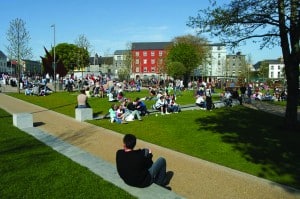
Ciaran Cuffe
It’s Sunday morning in the Phoenix Park. A group of Brazilians are playing football under the shadow of the Wellington Monument. In the distance a herd of deer look on. One suspects the Duke of Ormond would be happy to know that 350 years after he purchased the lands for a royal deer-park, deer and residents happily share the space.
Yet all is not well with the state of our parks. As cities increase in population development pressures threaten the future of green space. A new generation of city residents living in small apartments expect more from their parks, and cash-strapped local authorities find it difficult to meet changing expectations on shrinking budgets. The Phoenix Park itself is riven by roadways and has been described as “remorseless prairie, pitches and link-roads” with little of the sequestered charm of New York’s Central Park or London’s great parks. The Croppies Acre Park in front of Collins Barracks is currently closed to the public and was recently transferred from the Office of Public Works to Dublin City Council. The ambitious plans for a park at the Royal Canal beside the National Conference Centre in Dublin’s Docklands have not been realised. The Liffey Quays which could be a linear park from Heuston Station to Dublin Bay are choked with cars, with footpaths barely wide enough in parts for a single pedestrian. Uproar in certain quarters greeted proposals for traffic calming there. The park at Ormond Square in the north inner city has a sign banning football a few metres away from the plaque marking the birthplace of footballer Johnny Giles. Green spaces are often converted to ‘hard’ spaces as local authorities find them easier to maintain. Eyre Square and Wolfe Tone park are unfortunate manifestations of the tendancy.
However, there have been notable achievements in recent years. Ringsend Nature Park is a wonderful linear park between the city and the sea on the site of a former landfill site. St Catherine’s Park in Lucan combines old woodlands and playing pitches beside the banks of the River Liffey, and it must also be one of the few Irish parks with its own Twitter account. In Dublin’s North Inner City the City Council finally landscaped a derelict site on North King Street that had been in their ownership for a quarter of a century. It now has been grassed and planted with shrubs and trees and is a model for ‘temporary use’ parks that make use of lands that face an uncertain future. A similar approach was taken with Granby Park, a ‘pop-up’ park on Dominick Street last summer, though critics worry about the long-term legacy of temporary interventions. Nearby St Michan’s park on Green Street on the site of the site of an old jail provides a meeting place for Irish and immigrant families with a range of play facilities. The City Council has committed to reinstate the grassland integrity of Mountjoy Square.
At a time when funding is scarce much can be achieved with some creative thinking. Glasnevin Cemetery and the Botanic Gardens share a common boundary and recently opened up a gate allowing visitors to walk between the two, adding civic value at a low cost. A pedestrian crossing linking the National Gallery and Merrion Square could greatly increase access to one of the great Georgian Squares. Nearby, however, Fitzwilliam Square remains under lock and key, sharing the dubious privilege along with De Vesci Gardens in Dún Laoghaire of being private squares in neighbourhoods lacking in publicly accessible green space.
Little headway seems to have been made in addressing the ubiquitous challenges and opportunities of our post-war soulless suburban stretches of grass. Perhaps local councils, the Office of Public Works and indeed, crucially, Nama are not protecting and enhancing public spaces with the zeal and imagination necessary if they are to become engines for a transformation in our quality of life.
The role of parks and open space in fostering biodiversity is now recognised. The “Green City Guidelines” published in 2008 by the UCD Urban Institute, Dún Laoghaire Rathdown and Fingal County Councils showed how nature and green networks can be enhanced in cities and towns, even next to high-density urban developments. They also illustrated the importance of green roofs, green walls, permeable surfaces and sustainable drainage systems in protecting and enhancing the environment. More importantly they emphasised the importance of access to nature in an urbanising world. Guardian writer George Monbiot has written of the crucial role “re-wilding” of open spaces can play, not just in fostering biodiversity but in opening up human nature and imagination.
A debate is needed on the risks of promoting wild spaces where children are exposed to the real-life risks of climbing trees and encountering strangers and of the dangers in lost spontaneity, and lost exercise in a world of burgeoning obesity of cosseting our children in carefully manicured spaces and gated playgrounds with shock-absorbing surfaces.
Over the coming months in a series of articles Village will take a look at green and public spaces across the country and ask what needs to change to ensure that they are suitable for today’s needs. We will highlight the best and worst examples of the planning of open space and parks from recent years. •